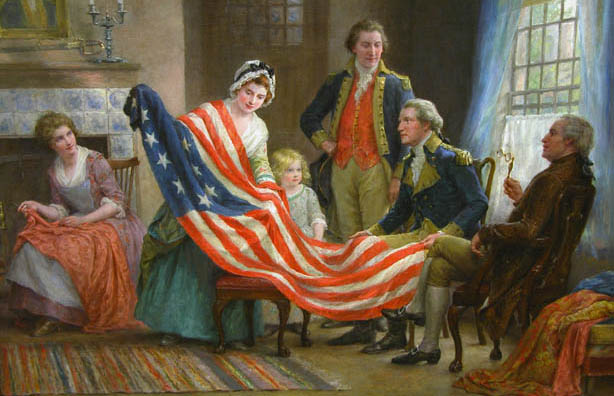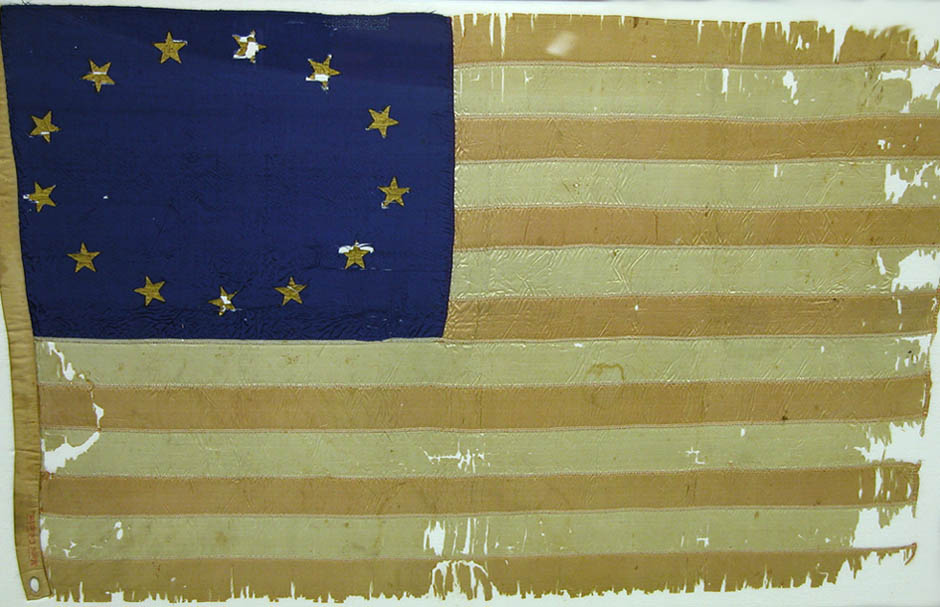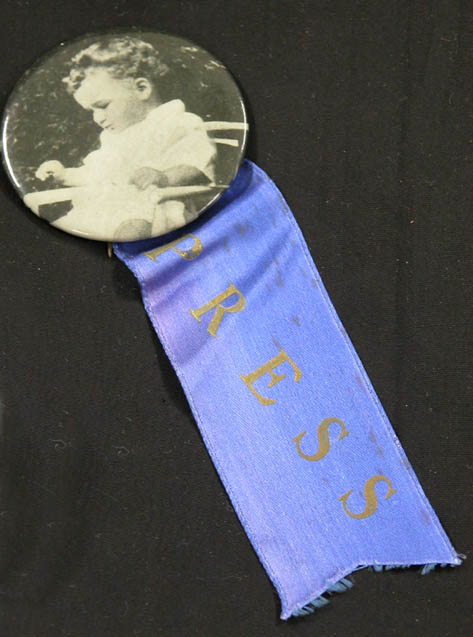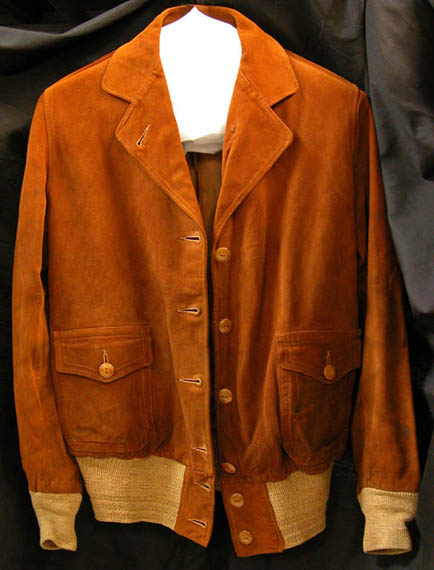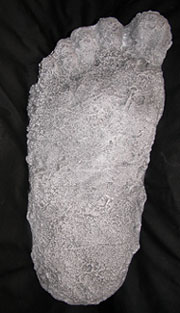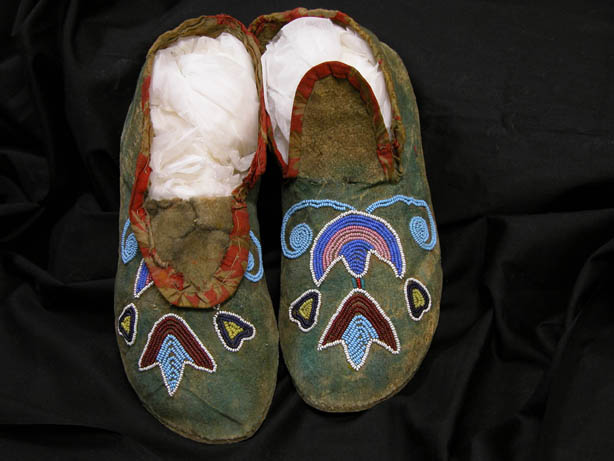
American Mysteries, Riddles, and Controversies!
New Exhibit at the Hoover Presidential Library
Challenges Visitors to Ask Better Questions in the Search for Answers
Summer 2007, Vol. 39, No. 2
By Timothy Walch and Maureen Harding
"It cannot be, therefore it is not."
"It could be, therefore it is."
Consider each of these statements as if it stood alone. Both reflect certitude, but not truth; neither allows for any nuance or subtlety. Ironically, life—past, present and future—as it plays out in our culture is not quite so black and white. Any study of the past indicates that great scientific discoveries and artistic creations were the result of work outside the rigid form of personal beliefs. Great advances in civilization, it seems, have come from those people who worked outside the "box" of certitude.
Historians and other investigators of historic mysteries tend to align themselves with one of two schools—"believers" or "skeptics." Conclusions tend to follow the framework of belief on any respective issue, no matter how intense the determination to remain neutral.
For example, believers who know that there was a second shooter at the Kennedy assassination will point to their evidence to "prove" their beliefs. Skeptics will counter by positing that the believers' evidence is fraudulent and that their own evidence points in a different direction. It is something of a maxim to say that both believers and skeptics often find the evidence they need to prove their prior beliefs. One side cannot convince the other, and for that reason, many historical questions remain controversial.
Such debates have led to a popular fascination with mysteries, riddles, and controversies in American history and a desire and determination to find "answers" to popular conundrums. These matters are common fare on cable television networks and movie screens across America.
Yet as much as historians and others may try, many historic questions still have no definitive answers. For that reason, the Herbert Hoover Presidential Library created an exhibition that explores 30 questions that continue to haunt American history. Some of the questions are vital and complex; others might be seen as trivial and inconsequential. No matter, they are all questions that stimulate discussion among segments of the American public from time to time. But fair warning to readers and exhibit visitors alike: even though one predominant "answer" may emerge in this exhibit, ongoing suspicions may not be dispelled in the minds of skeptics!
A unique aspect of this exhibit, which runs through October 28, 2007, is that many visitors leave with more questions than answers. That is not necessarily a bad thing. A wise old historian once said that the true quest of historical study is not to find answers but to learn to ask better questions! "American Mysteries, Riddles, and Controversies" is all about asking better questions. Join us as we review some of the mysterious elements of our American history: from the disappearance of the Anasazi culture to Amelia Earhart's doomed flight; from the Roswell Incident to the existence of Bigfoot; and from 9/11 to the Iraq War.
"What people think," said Abraham Lincoln, "is more important than what actually is so." Very true.
Visitors to "American Mysteries, Riddles, and Controversies" find themselves reconsidering what they think they know about history. The history that is read and taught in high school and college is part documentation and part interpretation, with a considerable dose of bias thrown in. Conclusions are a mix of hard evidence, reasoned analysis, forensics, beliefs, and intuition.
Why are historic answers so elusive?
Not surprisingly the answer is complex, and the reasons are numerous. First, historic accounts can be influenced by perceptions of the historians who record past events—matters such as politics of the time period or religious beliefs. Second, historic accounts frequently contradict each other, including—or particularly—eyewitness accounts. Third, historical evidence may be misleading or misinterpreted. Fourth, interpretation can be filled with speculation. Fifth, speculative information can gain more importance than validated proof because of personal bias. Sixth, historical evidence is not always convincing and does not always make sense. Finally, some evidence may have been destroyed so that all the facts may not be known. All of these reasons contribute to the search for answers.
The Hoover Library staff started with a long list of historical questions and, through an arduous process of elimination, settled on 30 intriguing questions that are grouped into six distinct categories. The first category includes five questions that all have been clouded by myth and legend: Was the first American flag sewn by Betsy Ross? Did George Washington ever smile? Was George Armstrong Custer responsible for the massacre at Little Big Horn? Was it really Billy the Kid who was shot by Sheriff Pat Garrett in 1881? Did Butch Cassidy and the Sundance Kid really die in a hail of bullets in Bolivia?
The second section of the exhibit is titled "Distorted Under City Lights" and focuses on the controversies that took place in big cities such as Washington, Chicago, Dallas, Memphis, and Los Angeles. For example, what questions still surround the Lincoln assassination? Was Mrs. O'Leary's cow to blame for the Great Chicago Fire? Did Marilyn Monroe commit suicide? Why does the assassination of John F. Kennedy remain so controversial? Did James Earl Ray act alone in assassinating Martin Luther King, Jr.? And finally, was Sirhan Sirhan the actual assassin of Robert F. Kennedy?
American suspicions about their elected leaders headline the third section of the exhibit by focusing on four issues that haunt the history of four presidencies. First, was Herbert Hoover responsible for the Great Depression? Second, did Franklin Roosevelt have prior knowledge of the Japanese attack on Pearl Harbor? Third, what actually happened in the Gulf of Tonkin that led to a resolution of war in Vietnam? Finally, what were the disastrous circumstances that led to the notorious Watergate conspiracy?
"Caught in Wide Open Spaces" is the title of the fourth section of the exhibit. The common theme here is the fact that these mysteries seemed to have taken place in plain view and yet questions remain. Here we address the issue of the Anasazi people abandoning their cities. We also want to know why Robert E. Lee ordered Gen. George Pickett to make his now-famous charge at Gettysburg. We also look into the disappearance of aviatrix Amelia Earhart. What happened to her in that vast southern Pacific Ocean? We are also curious about what happened in the little town of Roswell, New Mexico, in 1947. Is the government hiding evidence of extraterrestrial life? Two additional questions about space exploration end this section: Why did NASA proceed with the launch of the space shuttle Challenger in spite of the dangers? What were the causes and conditions that led to the destruction of the space shuttle Columbia?
The next cluster of questions is grouped into a section titled "Hidden in the Wilderness" because these troublesome incidents took place in locations where there were few witnesses or contemporaneous documents to record what happened. The first question in this section asks if Vice President Aaron Burr was guilty of murder and treason against the United States. The second question explores the troublesome death of Meriwether Lewis—did he commit suicide or was he murdered? And who actually kidnapped the baby of Charles and Anne Lindbergh in 1932? A final question in this group is one that stirs the passions of wilderness trackers and anthropologists alike: Where is Bigfoot?
The final section of the exhibit focuses on the very recent past—events that will remain controversial for many years to come. Because documentary evidence is so often filtered by true believers, the "facts" of each case may be little more than opinions. How did the events at Ruby Ridge lead to violence? Why did law enforcement authorities feel compelled to take such aggressive action against the Branch Davidians? What did two Gulf War veterans hope to accomplish by bombing the federal building in Oklahoma City? Why do questions still hover around the attacks of September 11, 2001? What are the facts behind the U.S. entry into the war on Iraq as a means of fighting terrorism?
As old as some of these questions are, there is little abatement of the intense search for solutions—even to the point of obsession. In fact, it seems that every generation elicits new efforts to use different technologies to resolve unanswered or problematic questions. For example, take the "Case of the Death of Billy the Kid." In 2004, more than 123 years after the event, investigators performed a luminal test on the bench where the Kid was supposedly laid after being shot by Sheriff Pat Garrett. Scientists also tested the drain in an adjacent washstand for remains of blood and DNA evidence. All this effort was made to determine if 21st-century science could shed some light on the violent event that was said to have taken place there in the late 19th century.
The investigators applied the luminal and waited until dark. According to historian David Turk, who was present during the testing, "the results were stunning. The elements of iron, so present in blood, would be in plain sight of the human eye. It showed a strong glow on one side of the workbench and on the underside. This signified a heavy blood loss. It was like seeing a ghost!" A swab used to collect traces of this material is on display in the Hoover exhibit. To date, however, the DNA test results have not been revealed. Science has proven that there was significant human blood loss at the site of the alleged crime, but was it Billy the Kid who lost all that blood?
Another group of investigators half a world away from New Mexico are exploring a different question, and the specific location of the tragedy is shrouded in mystery. What happened to Amelia Earhart on her last, fateful flight around the world? Unlike the investigations into the death of Billy the Kid, there is almost no physical evidence to reveal what happened to Earhart or her plane.
During recent investigations on the Southern Pacific island of Nokumura, investigators discovered tantalizing clues such as the sole of a woman's shoe similar to the ones worn by Earhart on her fateful trip—a 10-eyelet blucher-style Oxford, about size 9. This style was made in America in the mid-1930s. Was Earhart stranded on the island? If not, how did such a particular shoe end up in that remote location? Is this pure coincidence? The possible answers are intriguing.
The investigators also found a torn piece of aluminum with rivet holes and tangled copper wire with some of the rubber insulation still intact. The metal is compatible with Earhart's plane and is thought to have been manufactured before World War II. Even though temperatures in the shade on Nokumura exceed 100 degrees, another search by the International Group for Historic Aviation Recovery, better known by the acronym TIGHAR, is planned for 2007 if sufficient funds can be raised for the expedition. We seem to have more questions than answers—even after years of investigation.
Another question that continues to cause uproar in the scientific community is the very possibility of a mysterious two-legged beast of unprecedented size and power. Throughout the Pacific Northwest as well as other remote regions of the United States, the hunt is on for evidence of a hominoid called Sasquatch, Yeti, and Bigfoot, among other names.
Legends about such beasts are common in other parts of the world and in other centuries. For example, apelike beings have been reported to roam the forests and mountains of Indonesia to the Congo, Russia, Mongolia, and Canada. Are these accounts merely hoaxes, delusions, mistaken identities, or folklore legends? No one has found scientific proof of these creatures: no bones, no teeth, no conclusive DNA hair analysis.
The scientific community calls for credible evidence, but none has been discovered. Not surprisingly, most scientists have concluded that Sasquatch does not exist today and has never existed in the past. End of story? Not quite!
Even though many scientists scoff at the notion of a primordial beast, there are a few credible rebels who keep the controversy alive. "You'll be amazed," noted Jane Goodall in 2002, "when I tell you that I am sure they [Sasquatch] exist." Other scientists such as Jeffrey Meldrum of Idaho State University are even more passionate than Goodall in their search for Sasquatch. The public wants to believe in Bigfoot, and there is just enough questionable evidence to keep the dream alive.
The purpose of this imaginative exhibit is to educate and entertain our visitors with a selection of the mysterious issues of the American past. It was one thing to settle on the issues; it was another thing to come up with a representative selection of documents and objects that elucidate these issues. Almost by their very definition, these issues are problematic because there is little evidence—items such as photographs, documents, or memorabilia.
The Hoover Library staff met this challenge head-on by seeking interesting objects that embellish each story. For example, there is no indisputable proof that Betsy Ross sewed the first American flag, but in the exhibit we do have a piece of an actual American flag that was, in fact, sewn by Ross. For Butch and Sundance, we chose to display items from the classic film that starred Paul Newman and Robert Redford. Nothing survives of poor Amelia Earhart, but there is something very poignant about seeing the leather flight jacket and aerial map that she left behind. Poignancy also holds true for the memorabilia in the exhibit that accompanies the question about the Oklahoma City bombing and the terrorist attacks of September 11, 2001. These issues are so recent that these items are being displayed in public for the very first time.
The exhibit also includes a wide range of other unusual items. In addition to the pieces noted above, the memorabilia that have generated early interest are the noose that was used to hang Lincoln conspirator Mary Surratt, a copy of the Italian rifle used by Lee Harvey Oswald to kill John F. Kennedy, tools used by the famed Watergate burglars, the name tags of the astronauts who died in the Challenger explosion, and, of course, the plaster cast of an impressive footprint that is attributed to Sasquatch.
Where did we locate this incredible mélange of items? It is no secret that the Hoover staff has a national reputation of persistent begging. Making call after call, and sending e-mail after e-mail, the staff was able to find items that offered a special sense of intimacy to the exhibit. The lenders range from institutions such as the National Archives, other presidential libraries, the Smithsonian's National Air and Space Museum, and the Autry National Center to private collectors, scientists, and historians.
For more than 20 years, the Hoover Presidential Library has mounted original exhibitions on a broad range of historical subjects. To be sure, aspects of the presidency have been a common theme among these exhibits. But the staff also has addressed issues as distinct and unexpected as the Revolutionary War, the culture of the 1950s, the Civil War, western film stars, Laura Ingalls Wilder, and much more.
No exhibit has been as imaginative or ambitious as "American Mysteries, Riddles, and Controversies." It is our hope that this exhibit will, as they say, "scratch an itch," challenging our visitors to learn more about these and other complex issues in American history.
Just as important, we hope this exhibit will spark families of visitors to talk to one another about what they are reading and seeing. In fact, we hope that family members will call to each other as they tour the exhibit. "Come here," we hope to hear, "Look at this."
From Betsy Ross to Bigfoot, "American Mysteries, Riddles, and Controversies" combines light-hearted history with disastrous events, affairs of the heart with affairs of the home, and the romanticism of the Wild West with contemporary political debates. Represented in this exhibit are elements of ancient culture, science, art, politics, economic depression, conspiracy, scandal, religion, space technology, patriotism, treason, cover-ups, racism, war, tragedy, comedy, raging infernos, military blunders, murder, suicide, movie stars, outlaws, aliens, duels, love, hate, and the horrors of early dentistry! That's quite a list, but after all, these are all ingredients in the great saga we call the American experience.
Timothy Walch has been the director of the Herbert Hoover Presidential Library-Museum in West Branch, Iowa, since 1993. He is the author or editor of 16 books of American history and a former editor of Prologue.
Maureen Harding has been the curator of the Herbert Hoover Presidential Library-Museum since the mid 1980s. "American Mysteries, Riddles, and Controversies" is one of more than 20 original exhibits she has curated at the Hoover Library over the past two decades.
